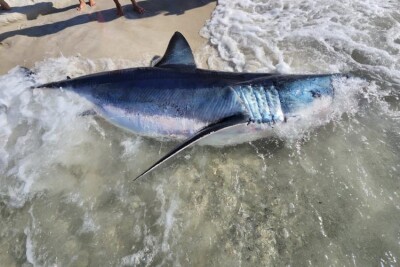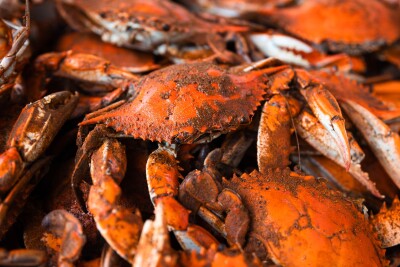Gulf/South Atlantic Tuna
Summer and fall outlook up from '08, if sour economy doesn't dim demand
While prospects for a good summer and fall season remain alive for yellowfin tuna, the duration of the recession and its effects on high-end products like sashimi and tuna steaks in gourmet restaurants are anybody's guess at this point.
By March of this year, yellowfin tuna fishing in the Gulf of Mexico was decent again after a troubled end to 2008, with ex-vessel prices for No. 1-grade fish OK at $6 to $6.50 a pound, according to a dockside report from Dulac, La. That's down from highs of $7 to $8 a pound following the 2005 hurricanes but in line with prices seen for the last couple of years.
"Landings have been pretty steady," says David Maginnis, vice president of Houma-based Jensen Tuna. "It's been pretty good."
The early 2009 fishing was a welcome improvement after yet another storm-plagued fall. Hurricanes Gustav and Ike pounded the west-central Gulf Coast within two weeks of each other in early September, bringing business to a standstill.
"At our dock here in Dulac, pretty much the hub of the tuna business, we had water over the dock," Maginnis says. "We didn't have ice, couldn't supply the boats with ice."
The storms knocked Jensen out of business for almost two months, Maginnis says.
Preliminary landings data from NMFS through August 2008 for Louisiana suggests prices overall were higher — $3.60 a pound compared to $3.39 a pound — than the previous year, while landings dropped. If final numbers confirm that 2008 pre-hurricane landings were down from 2007 levels, this probably reflects reduced effort caused by extremely high diesel fuel prices on top of the normal high cost of outfitting a tuna vessel. At worst, diesel was pushing $5 a gallon last July.
In North Carolina, the fleet hadn't really begun catching tuna yet in March. Yellowfin landings generally begin picking up in April, says Steve George, general manager of Willie R. Etheridge Seafood in Wanchese, N.C.
"We've just been doing croakers and bluefish," George says.
Diminished effort played a role in slower 2008 landings in North Carolina, too, where, in one of those odd cycles, one type of gear catches fish and another doesn't. Overall, both landings and effort were down, George says.
"It wasn't one of our good years," he says. "I think there just wasn't as many boats doing it."
Only longliners had much success.
"The hook and liners didn't do anything," George says. "The longliners held their own. One of my [hook and line] fishermen just didn't go out at all after the summer."
North Carolina landings information for 2008 also was preliminary, and some of the numbers are confidential because of the small number of dealers reporting. But overall they indicate a decrease in yellowfin production with prices generally holding steady at about $1.65 per pound compared to 2007.
While the yellowfin landings drop on both coasts is disappointing in the short run, it's not particularly worrisome for the long term.
"Everything runs in cycles," George says. "It might be a big year this year."
According to NMFS, the "Atlantic yellowfin tuna stock biomass level is estimated to be 96 percent of the level needed to support maximum sustainable yield" and isn't being overfished. Fish caught in the Gulf of Mexico are part of the Atlantic stock.
Rounding out a consistent picture in the Southeastern fishery, preliminary state figures suggest Florida landings also dropped in 2008, to 434,385 pounds from 755,385 pounds in 2007, with price increasing to $3.71 from $3.22 in 2007. It should be noted, however, that the 2008 landings are more typical of the past few years.
Although hurricanes Gustav and Ike made landfall in Louisiana and Texas, Florida fishermen still felt their effects, said Greg Abrams, owner of Greg Abrams Seafood in Panama City, two days after Ike hit Texas last year. "The hurricanes really mess up tuna fishing," he said.
In March, diesel prices in the gulf and on the Atlantic coast remained low, a big plus for the pelagic fleet, at about $1.60 a gallon in Wanchese, N.C.
Fortunately for domestic market share, imports of fresh yellowfin also dropped in 2008 compared to 2007, and the trend appears to be continuing this year. Fresh yellowfin imports for January 2009 dropped to $9.5 million compared to $11.2 million for January 2008, according to NMFS statistics. Total fresh yellowfin imports in 2008 dropped to $129.6 million versus $137.4 million in 2007. — Hoyt Childers
Alaska/Pacific Salmon
Alaska forecast rosy with pricier pinks; West Coast trollers again face closure
While Alaska fishermen ready their nets for this season's projected harvest of 175 million salmon, the West Coast industry is bracing for another tough year.
Alaska's pink salmon prices climbed sharply in 2008, and with bountiful harvests in key production areas of Southeast Alaska, Prince William Sound and Kodiak, seine fishermen made money like they hadn't in years.
Alaska pink salmon harvesters once routinely complained they couldn't get more than a nickel a pound for their catch. Since 2005, however, demand for pink salmon roe, frozen and canned products has bloomed.
Consequently, average prices have climbed steadily from 12 cents to 16 cents in 2006, then to 17 cents in 2007, according to Alaska Department of Fish and Game data. Last year, ex-vessel offers averaged 29 cents per pound, statewide. Offers in Southeast and around Kodiak hit a respective 27 cents and 30 cents, while processors in Prince William Sound paid 33 cents per pound.
"The strong price was driven by a combination of factors, including continued growth in the average first wholesale price of frozen and canned pinks and a major increase in the first wholesale value of pink salmon roe," says Chris McDowell, project manager for the Alaska Seafood Marketing Institute's Salmon Market Information Service, in Juneau.
Whether pink salmon seiners and the rest of Alaska's salmon fleet continue to prosper depends on several factors. One is the amount of credit banks will agree to extend to seafood processors for "pack loans" this year.
In years past larger processors could secure enough cash to buy up substantial volumes of product and hold inventories for sales throughout the year. But the global credit crunch may cause them to buy and hold less product, sell that product, then seek credit to buy more fish. If that's the case, processors may reduce ex-vessel prices in hopes of accumulating more volume while simultaneously reducing risk exposure.
Predicting the fallout from the economic downturn is difficult because many variables are involved, says Gunnar Knapp, professor of economics at the University of Alaska, Anchorage.
"We really don't know yet how the economic crisis will affect the Alaska seafood industry because we don't know how the economic crisis will play out — over the next two months, through the summer, through the subsequent salmon marketing season," Knapp says. "Processors don't know either."
Among positive ex-vessel price drivers for 2009, Knapp says, is a disease-related decrease in Chile's farmed Atlantic production. And the relative strength of the Japanese yen against the U.S. dollar and the euro won't hurt the industry.
Unfortunately, the outlook isn't so rosy for West Coast salmon trollers, who last year suffered another in a string of dismal seasons.
Last year's lack of chinooks brought the West Coast salmon industry $170 million in disaster relief funding last September. Anticipating the likelihood of another catastrophic season this year, California reserved $50 million of 2008 disaster relief money to aid Golden State trollers in 2009.
"California held some of its [disaster relief] share back because it didn't look like we were going to have another season this year," says Zeke Grader, executive director of the Pacific Coast Federation of Fishermen's Associations.
The financial package aimed to keep fleets afloat
in Washington, Oregon and California, where, according to Pacific Coast Fisheries Information Network figures, revenues for all salmon species caught off the West Coast have slipped steadily from more than $49 million in 2004 to $26.6 million last year.
This year 122,196 fall chinooks — barely above the minimum escapement threshold — are expected to hit the Sacramento River. Industry members and Pacific Fishery Management Council members met in March to develop commercial fishery options, though no one expected there to be a commercial season.
"For California and Oregon, it doesn't look like there's going to be anything," Grader said prior to the April meeting.
Sure enough, the council in April scuttled the 2009 California salmon season, and most of Oregon's, too, prohibiting chinook fishing south of Cape Falcon.
Meanwhile, escapement counts for the Klamath and the Columbia river systems are projected at 81,000 chinooks — double the management goal of 41,700 spawners — and more than 1 million hatchery cohos, respectively. Those predictions are sufficiently above the minimum thresholds needed to conduct the fisheries.
Average chinook prices for the three states climbed from $2.76 in 2006 to $3.46 in 2007 but fell to $2.54 last year. Prices for the more abundant cohos, meanwhile, climbed from $1.25 to $2.79 and up to $4.75 during the same period. — Charlie Ess
Northeast Scup
One-time 'ethnic' fish is now making inroads with foodies, fine diners alike
Scientists' reassessment of scup data this winter pegged the East Coast stock at 130 percent of the biomass rebuilding goal. That takes porgies way out of the overfished status of recent years that veteran captains always disputed.
"The industry has finally been rewarded for its patience... We can desperately use whatever fish we can catch," says dragger captain Chris Brown, president of the Rhode Island Commercial Fishermen's Association. "We got these fish back through conservation. We gave sacrifices, and fishermen need to see that when we get something back from conservation, we deserve it."
A longtime staple in so-called ethnic markets, porgies are one round-fish species that appear now in fancy restaurants and foodie circles, with ex-vessel prices over $2 a pound at times. In this recession it could be affordable protein again, if fishermen recapture their market after years of enforced scarcity.
The 2009 total allowable landings are up to 11.18 million pounds from 7.34 million pounds in 2008. Science advisors reckoned the maximum yield could be 16 million pounds but managers are going with a more conservative limit.
While fishing pressure was kept low by conservative limits in recent years, "the stock has been increasing a lot," scientist Jim Weinberg of the Northeast Fisheries Science Center told the Mid-Atlantic Fishery Management Council in February.
"They were out there. They were just in different areas than they traditionally were," Wanchese, N.C., skipper Jimmy Ruhle told the council.
Ruhle carried the Northeast Area Monitoring and Assessment Program research group on his boat Darana R when they found abundant scup on their research tows in 2008.
Commercial landings averaged around 9.3 million pounds annually from 2003 to 2007 — nothing like the 42 million pound averages of the early 1960s. The NEAMAP findings elicited much anticipation among biologists and fishermen, but their data on scup and other species have not run long enough to figure into assessments.
Even without using that inshore survey, biologists made major revisions to understanding the scup population. In the last weeks of 2008 the "data-poor stocks" working group sponsored by the Northeast Fisheries Science Center revisited scup, along with skates, red deep sea crab, Atlantic wolffish and black sea bass.
They used a population model called an age-structured assessment program, or ASAP, to set biological reference points for scup. In the working group's summary, science center biologist Mark Terceiro wrote that this new model may "represent a more stable approach for monitoring stock status and specifying annual fishery regulations," versus relying on spawning stock biomass indexes calculated from spring trawl surveys.
Some modeling results indicated that scup catches could potentially approach the good old days, at least in the long term. But given stock recruitment uncertainty and the models biologists are using, scientists recommended taking a slow approach to widening the fishery.
The science and fishermen's observations had been at odds for several years, with captains weighing out better catches from southern New England to New Jersey and catching those fish faster. It's a fishery famous for either slow picking or massive hauls. In past years processors tended to freeze and hold scup during gluts.
Now, "this economy's so bad. Usually they freeze these fish, but dealers have been dumping them on the market" to avoid storage costs, Brown says.
It's encouraging to see better catches and bigger porgies, but "it's always a problem when the supply is not steady," says dealer David Weiss of Blue Ribbon Fish Co. at the New Fulton Fish Market in New York.
From his vantage point, Weiss sees there the possibility of an economic advantage to fishermen and management stability by fishing on recovered stocks like scup and summer flounder to provide steadier supply.
"Here we are more than a week from the end of Lent, and we have almost no porgies," Weiss said on the last day of March. "Two weeks ago we were getting 15,000, 20,000 pounds."
"Our last porgies were $2.50 a pound. A couple of weeks ago we were paying 50 cents and $1 for big fish," Weiss says. "We love having all these fish. But if they could balance out the supply with the demand, it would be much better all around."
"It's very frustrating. We all go scup fishing, and crash the market," Brown says. "We've got to find a way to keep these markets open year round. But I don't know if the quota system is capable of doing that." — Kirk Moore






